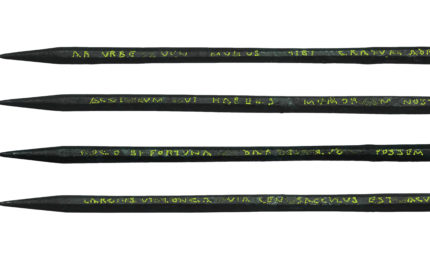An iron stylus inscribed with a quip reminiscent of many a hokey souvenir t-shirt has been found in central London. One of thousands of exceptional Roman treasures unearthed during the Museum of London Archaeology excavation of Bloomberg’s future European headquarters, the inscription makes this stylus unique. Inscribed Roman styluses are extremely rare finds anywhere in the empire, and the length and wit of this one makes it a stand-out piece.
The pens were used to write on wax-coated wooden tablets, more than 400 of which were discovered at the Bloomberg dig, extremely rare survivals that were preserved in the waterlogged soil of the lost Walbrook river. MOLA archaeologists also found more than 200 styluses in that same excavation, and only this one had an inscription.
When it was first discovered during the 2010-2014 excavation, corrosion obscured the inscription making it illegible. The fact that it could be recovered at all is a tribute to the Walbrook’s powers of preservation. For years MOLA conservators have worked painstakingly to bring its clever wording back. Epigrapher Dr. Roger Tomlin was able to decipher and translate the tiny lettering:
‘ab urbe v[e]n[i] munus tibi gratum adf(e)ro
acul[eat]um ut habe[a]s memor[ia]m nostra(m)
rogo si fortuna dar[e]t quo possem
largius ut longa via ceu sacculus est (v)acuus’‘I have come from the City. I bring you a welcome gift
with a sharp point that you may remember me.
I ask, if fortune allowed, that I might be able (to give)
as generously as the way is long (and) as my purse is empty.’In other words: the stylus is a gift to remind the recipient of its sender; the sender acknowledges that it is a cheap gift and wishes that they could have given more.
The stylus dates to around 70 A.D., when Londinium was a thriving commercial and administrative center. The inscription is a glimpse into the links connecting people even at the outer edges of the empire with the Caput Mundi.
The conserved stylus is going on display for the first time at the Ashmolean Museum’s Last Supper in Pompeii exhibition.
